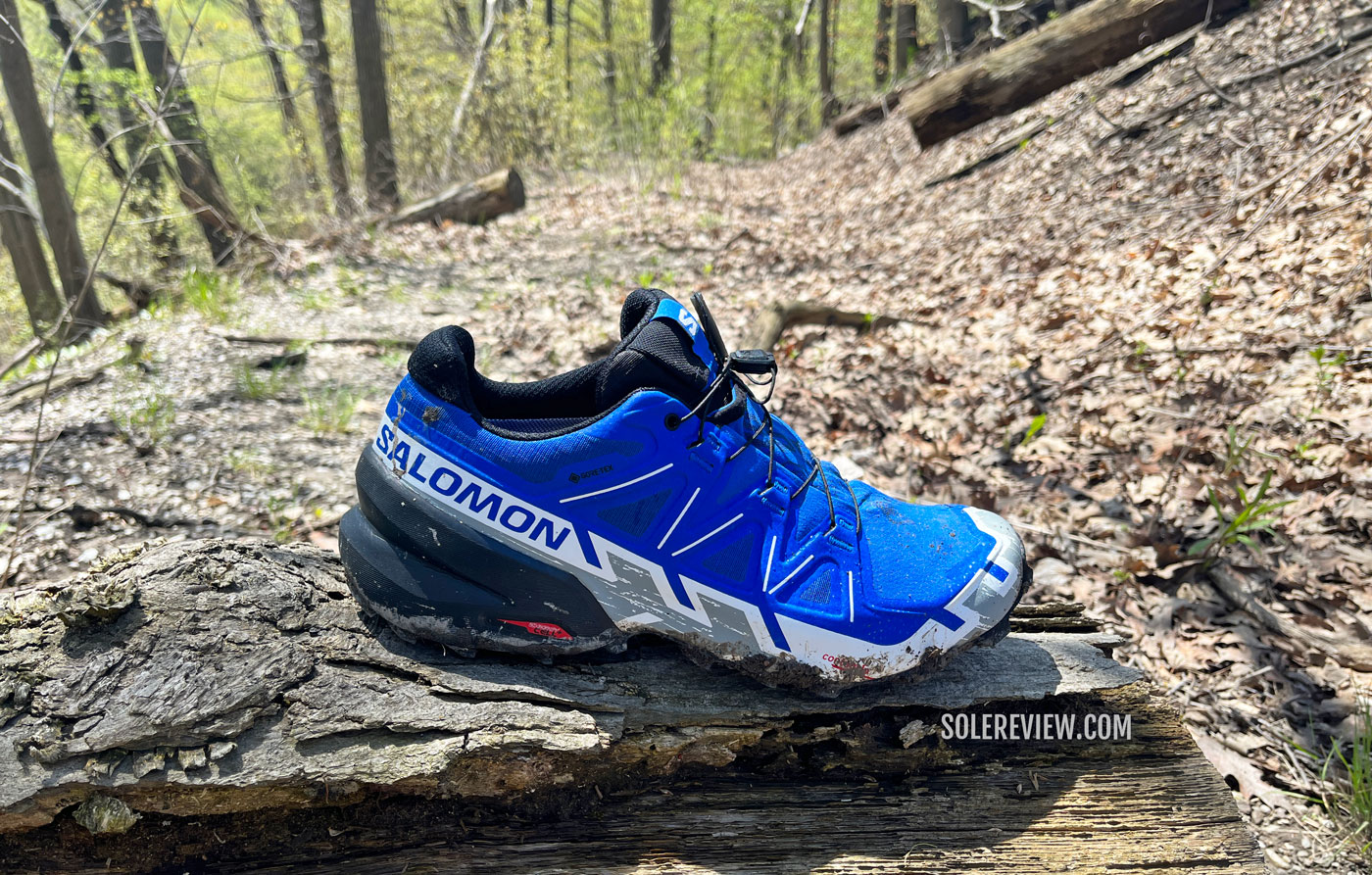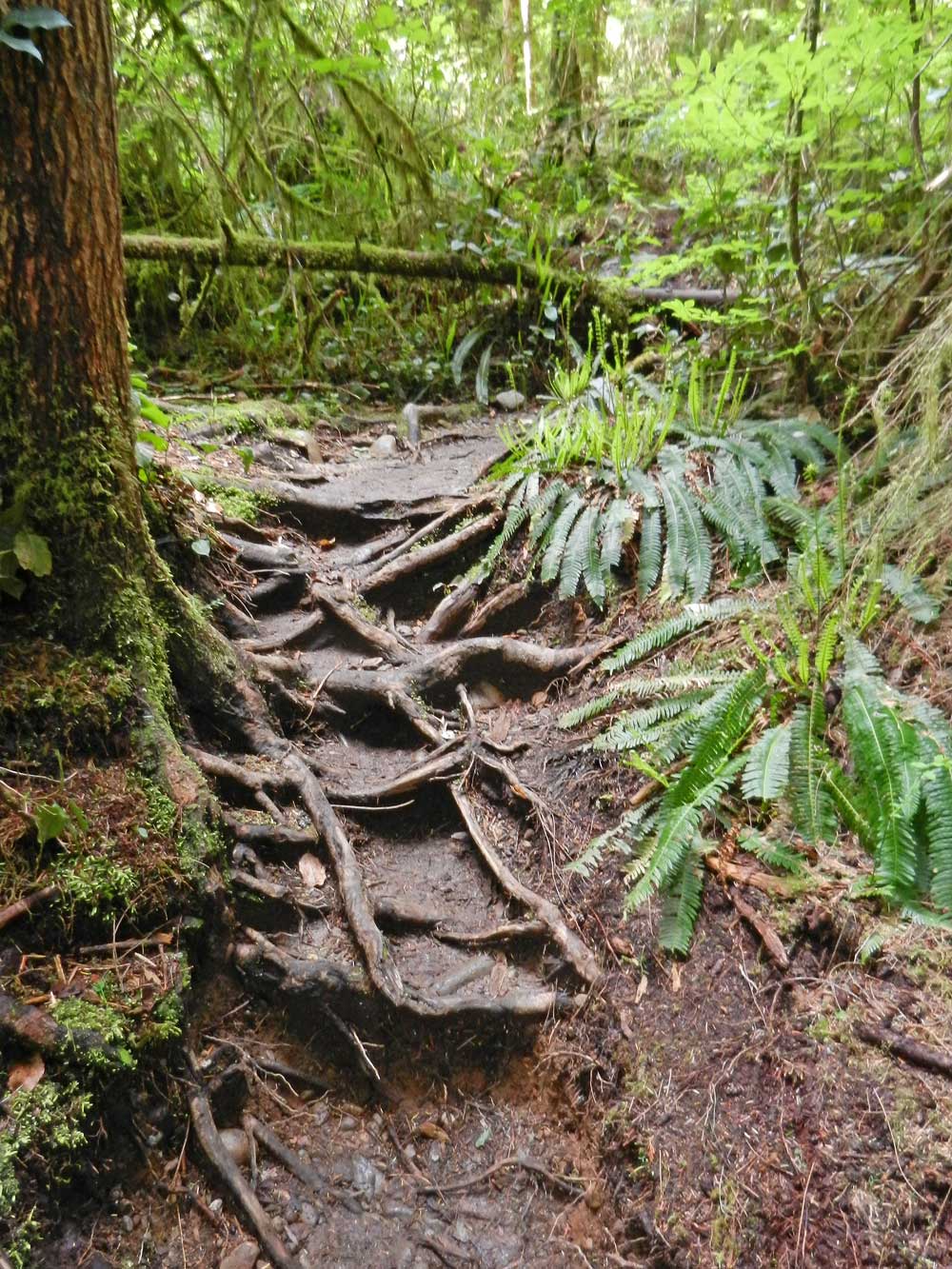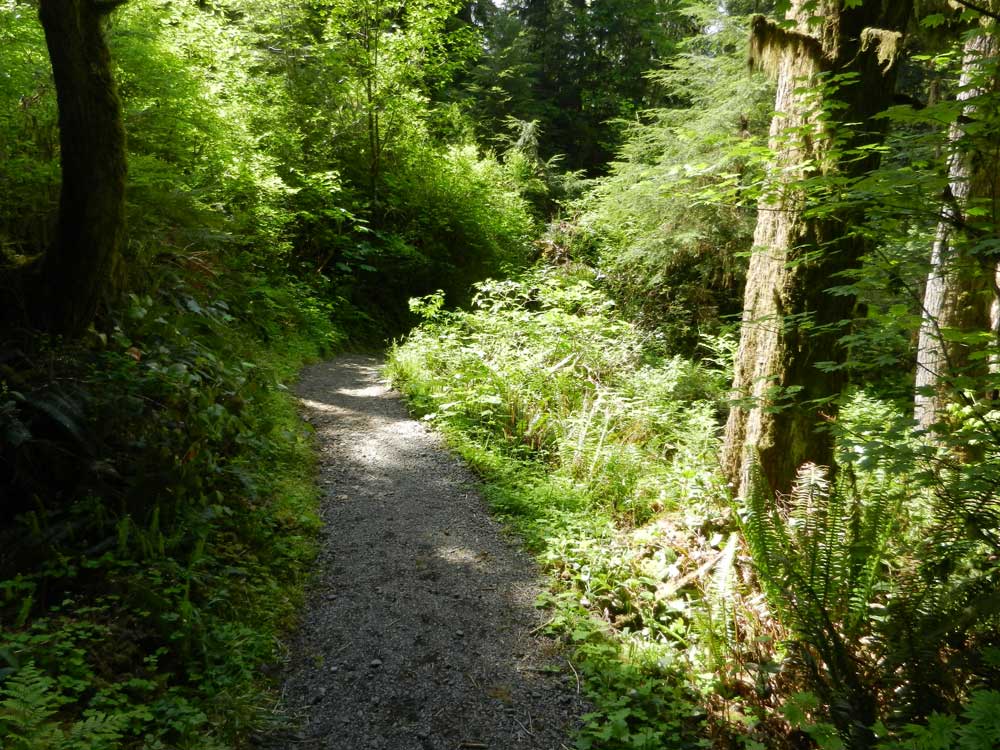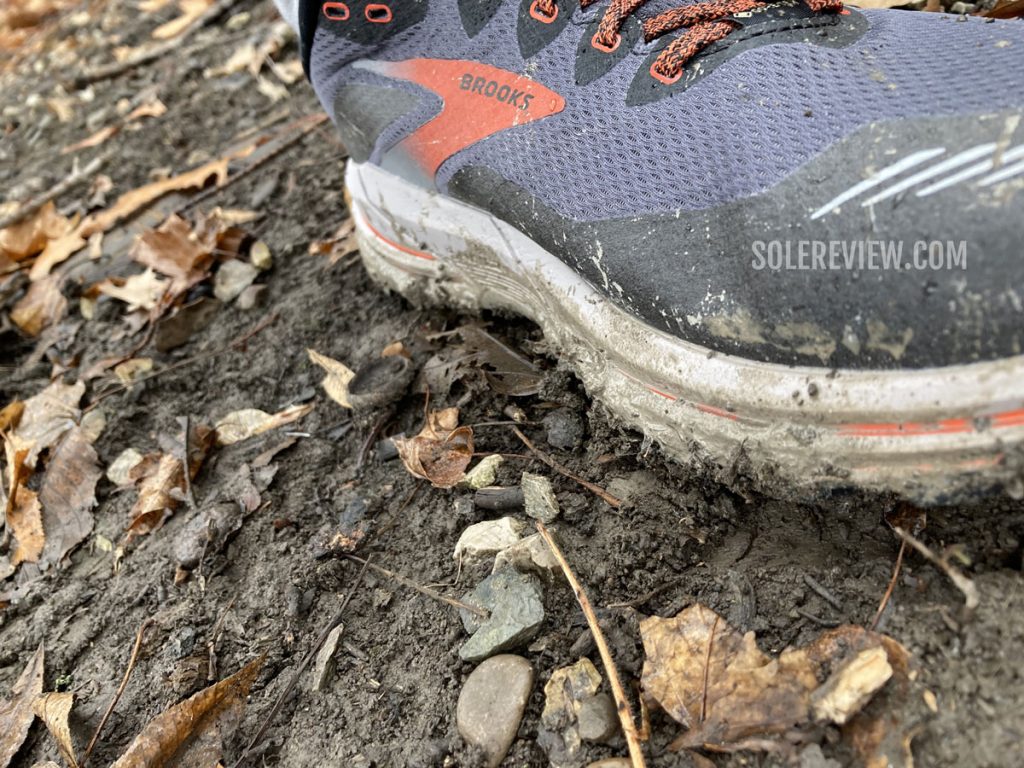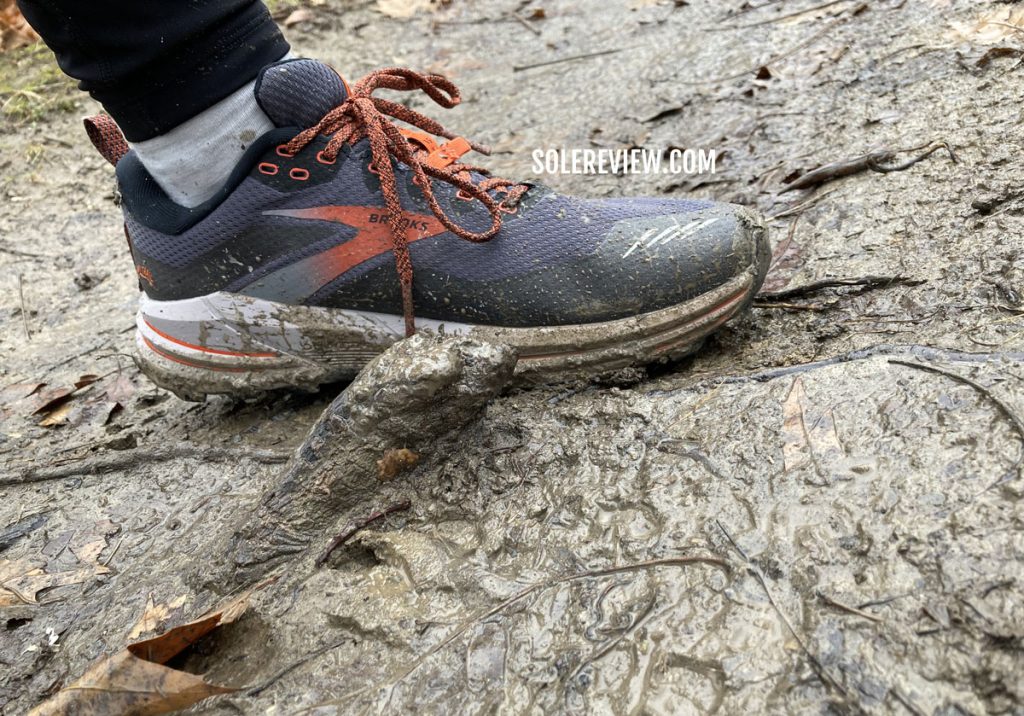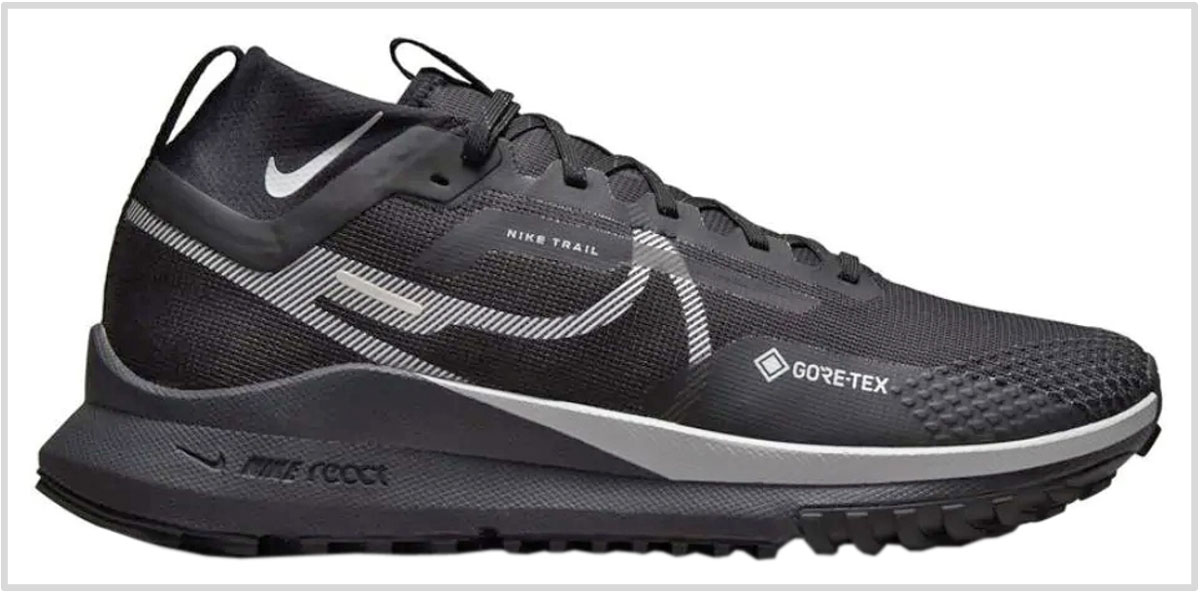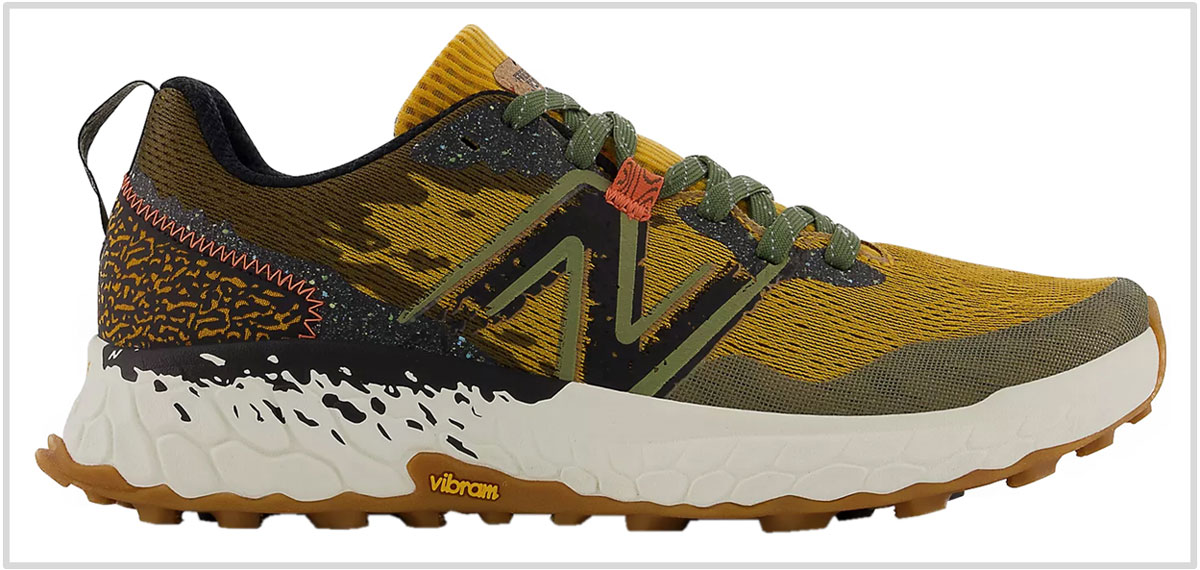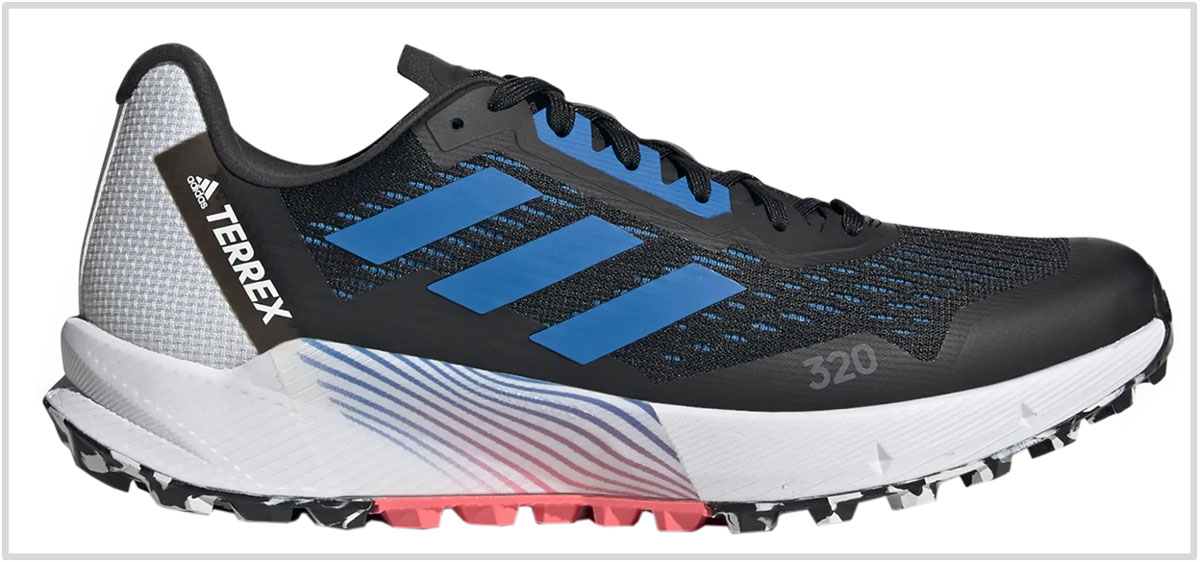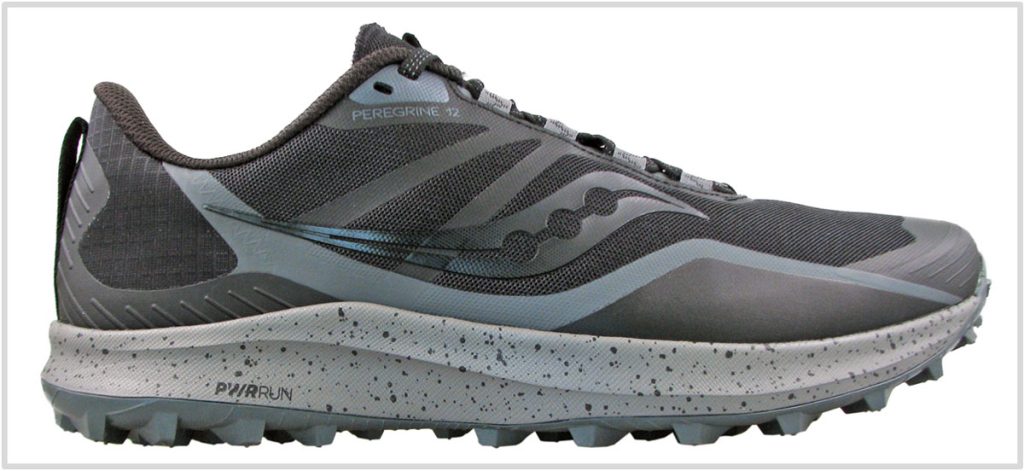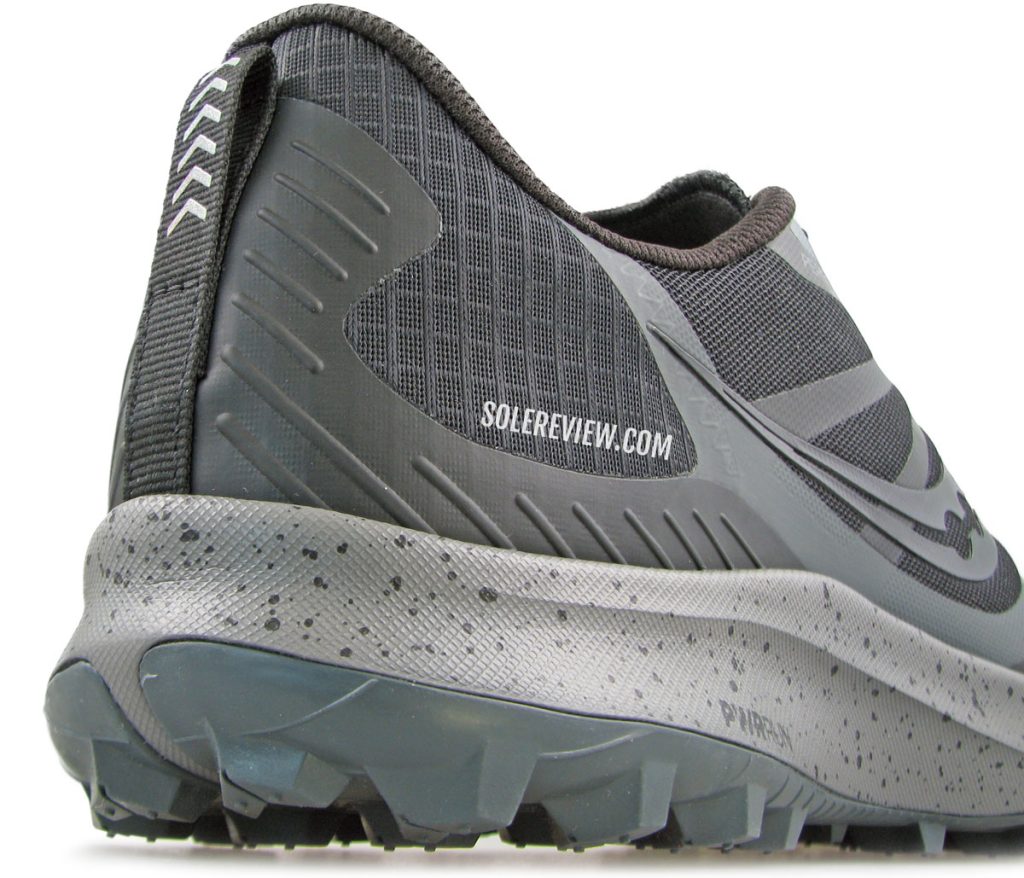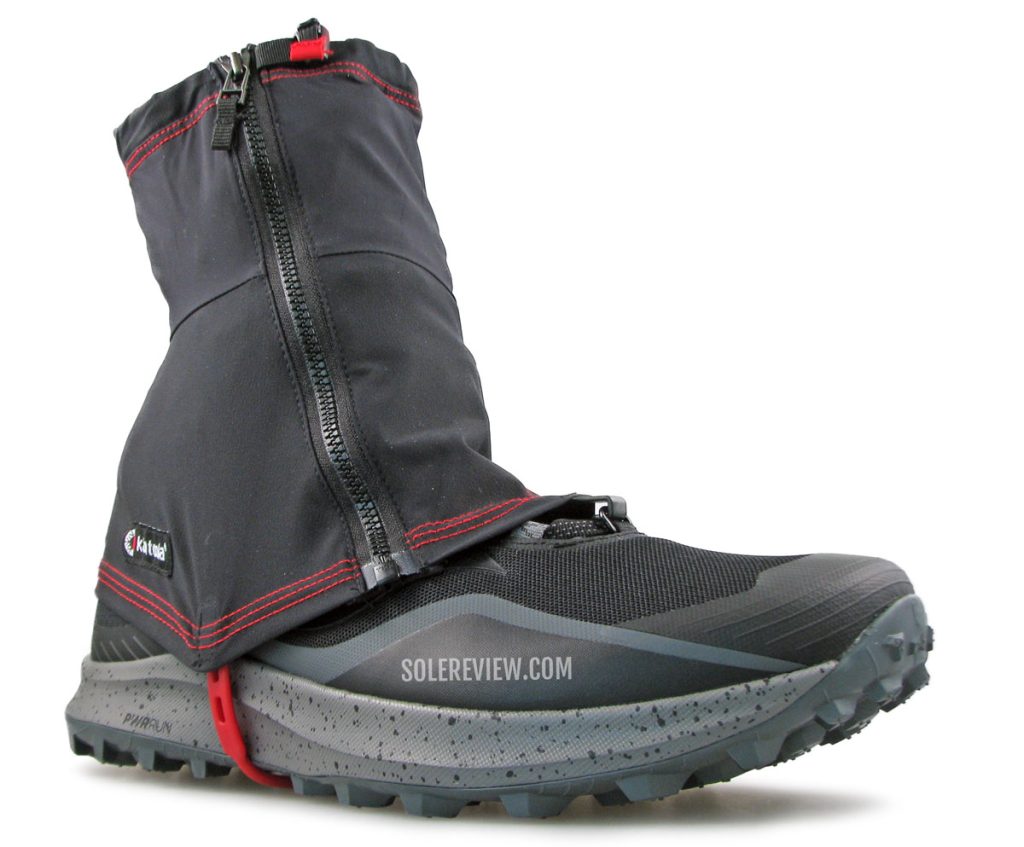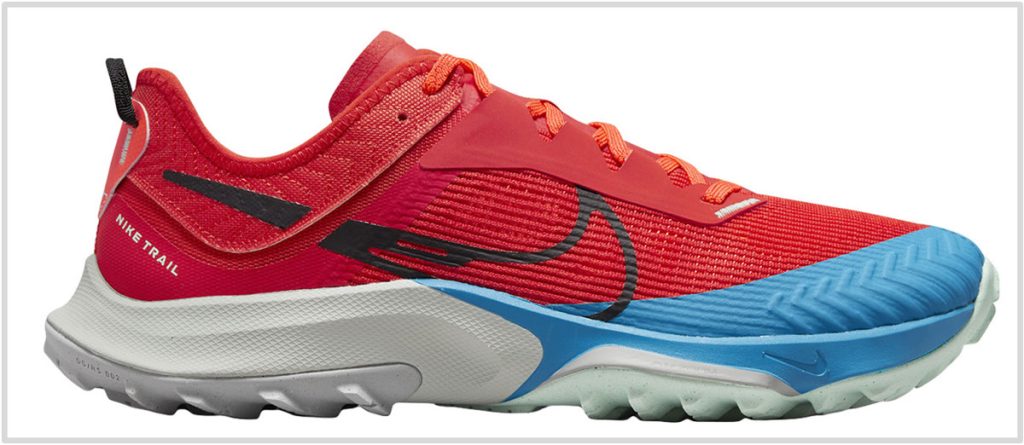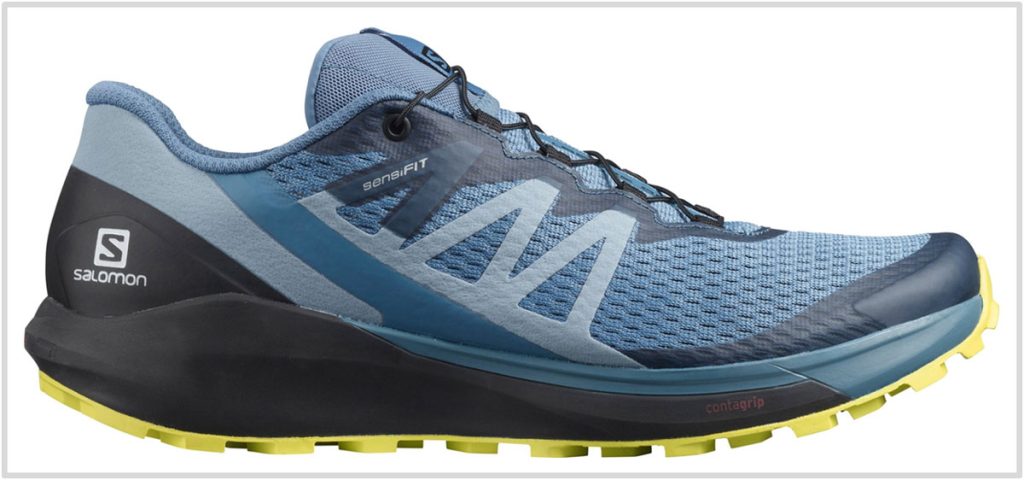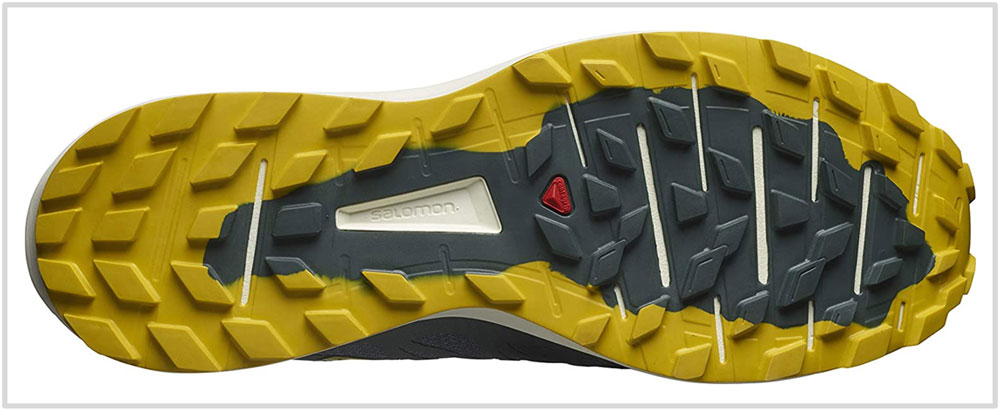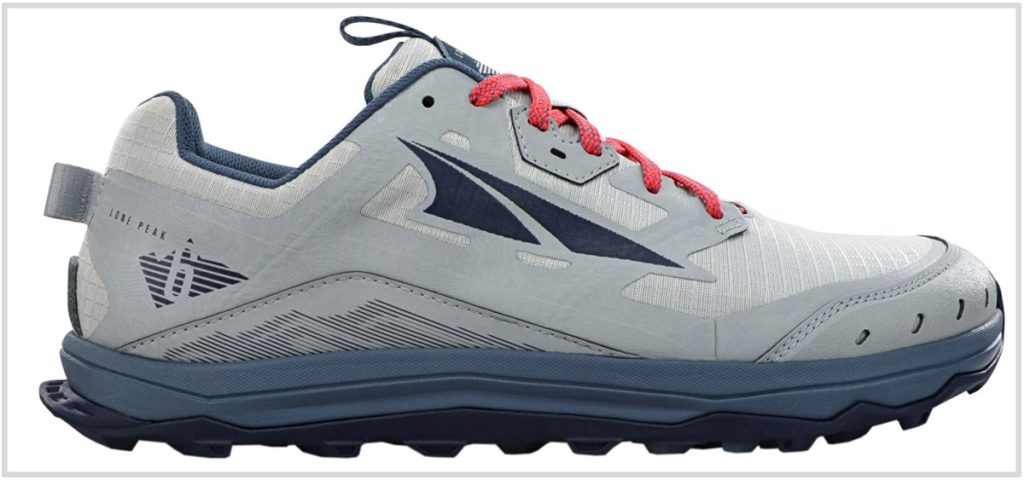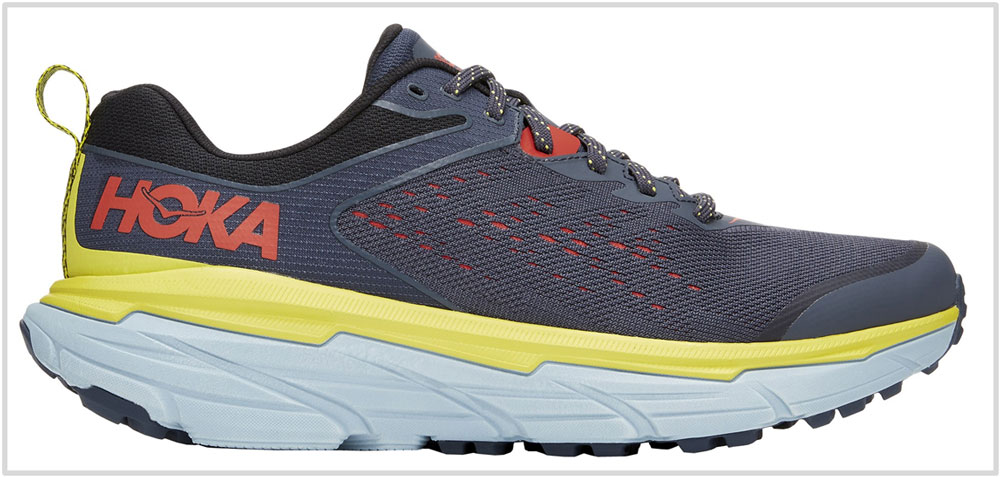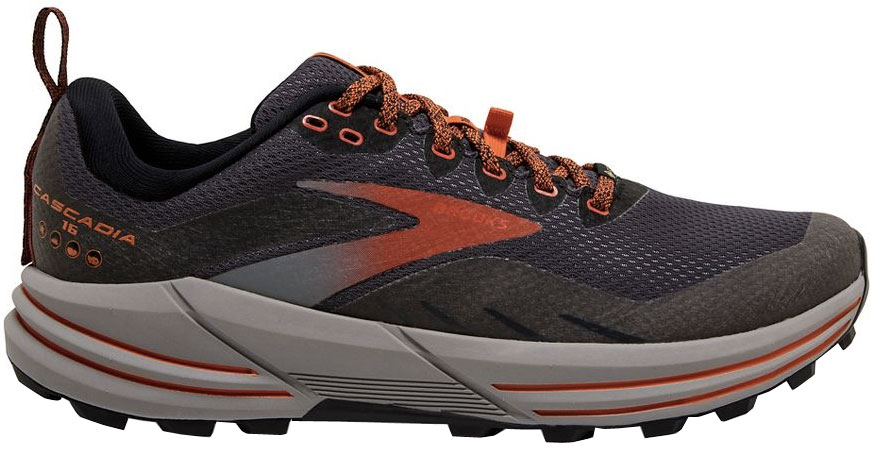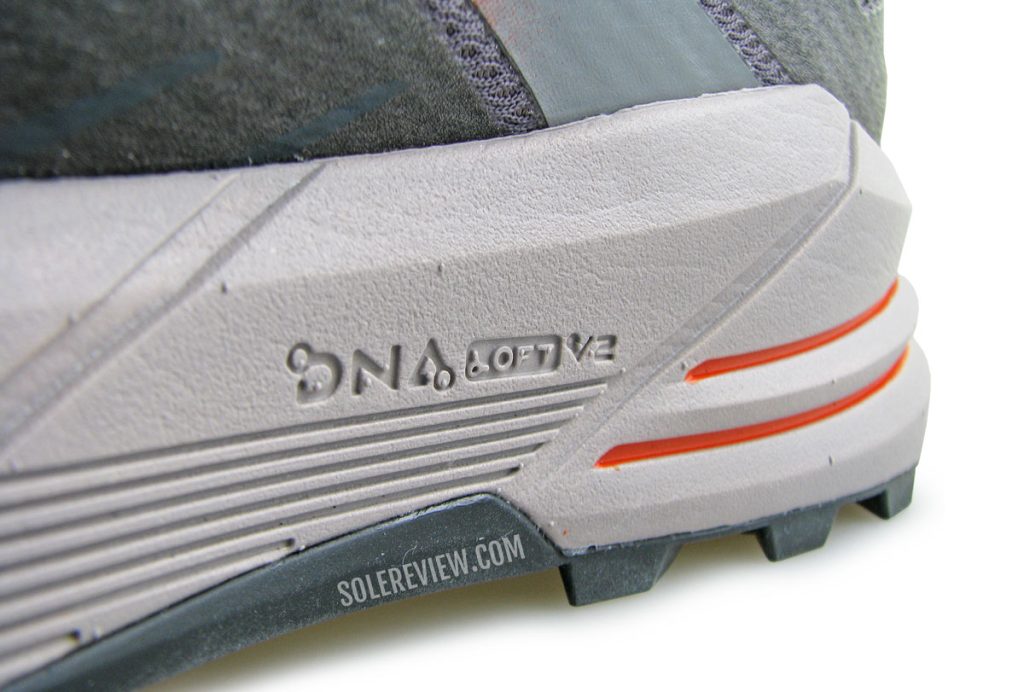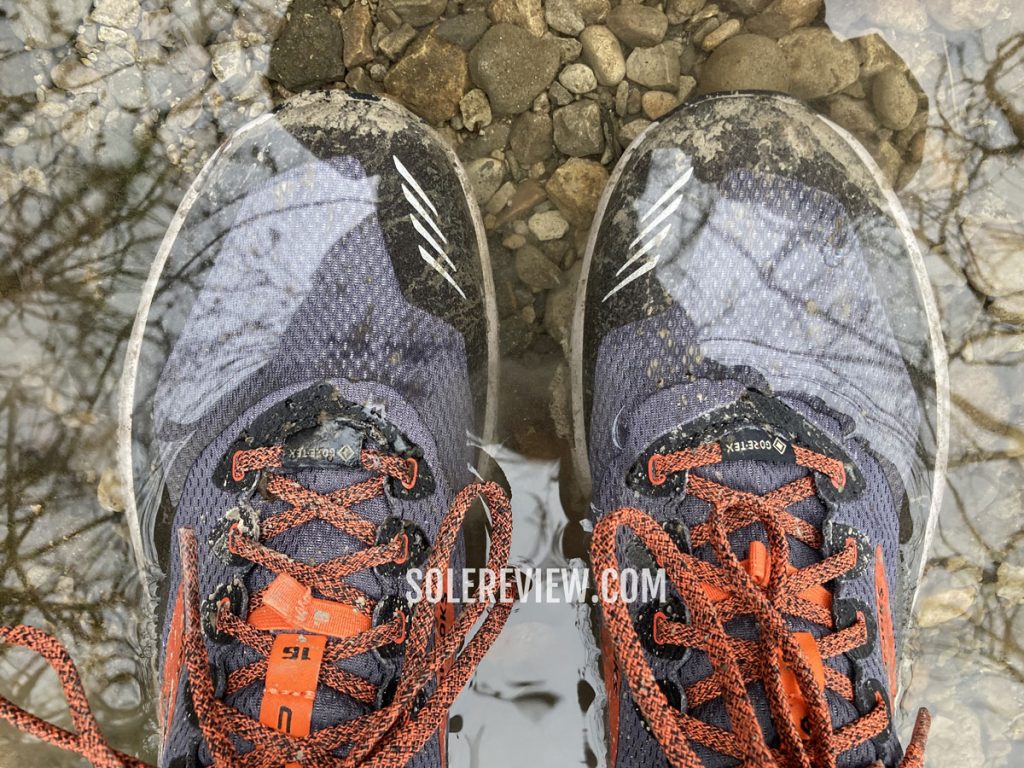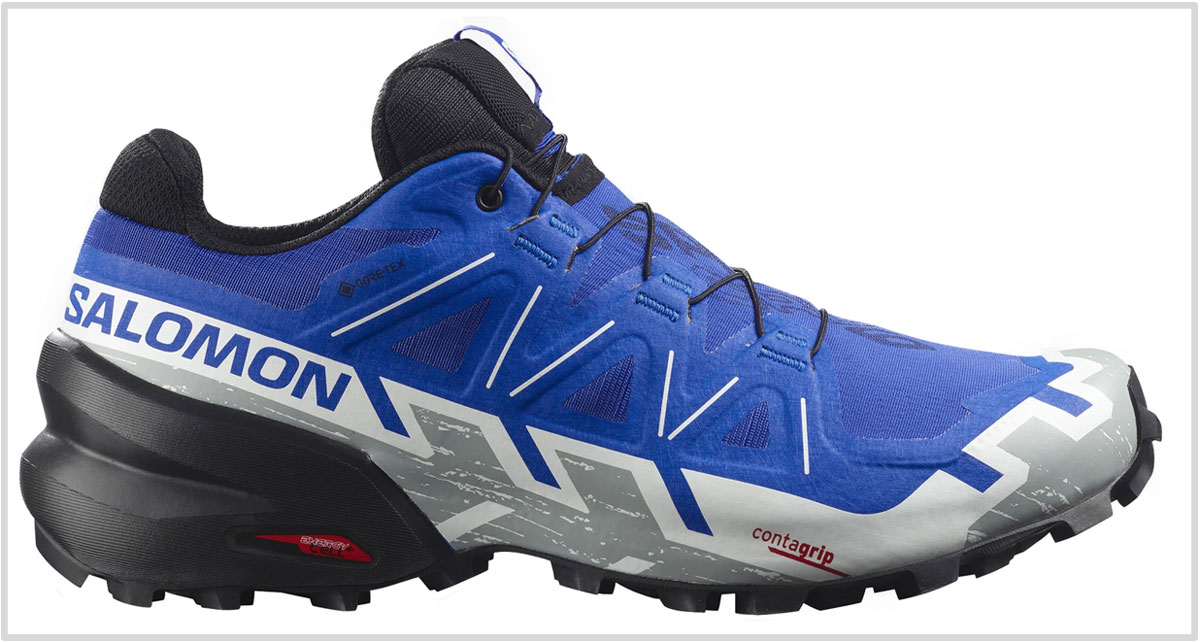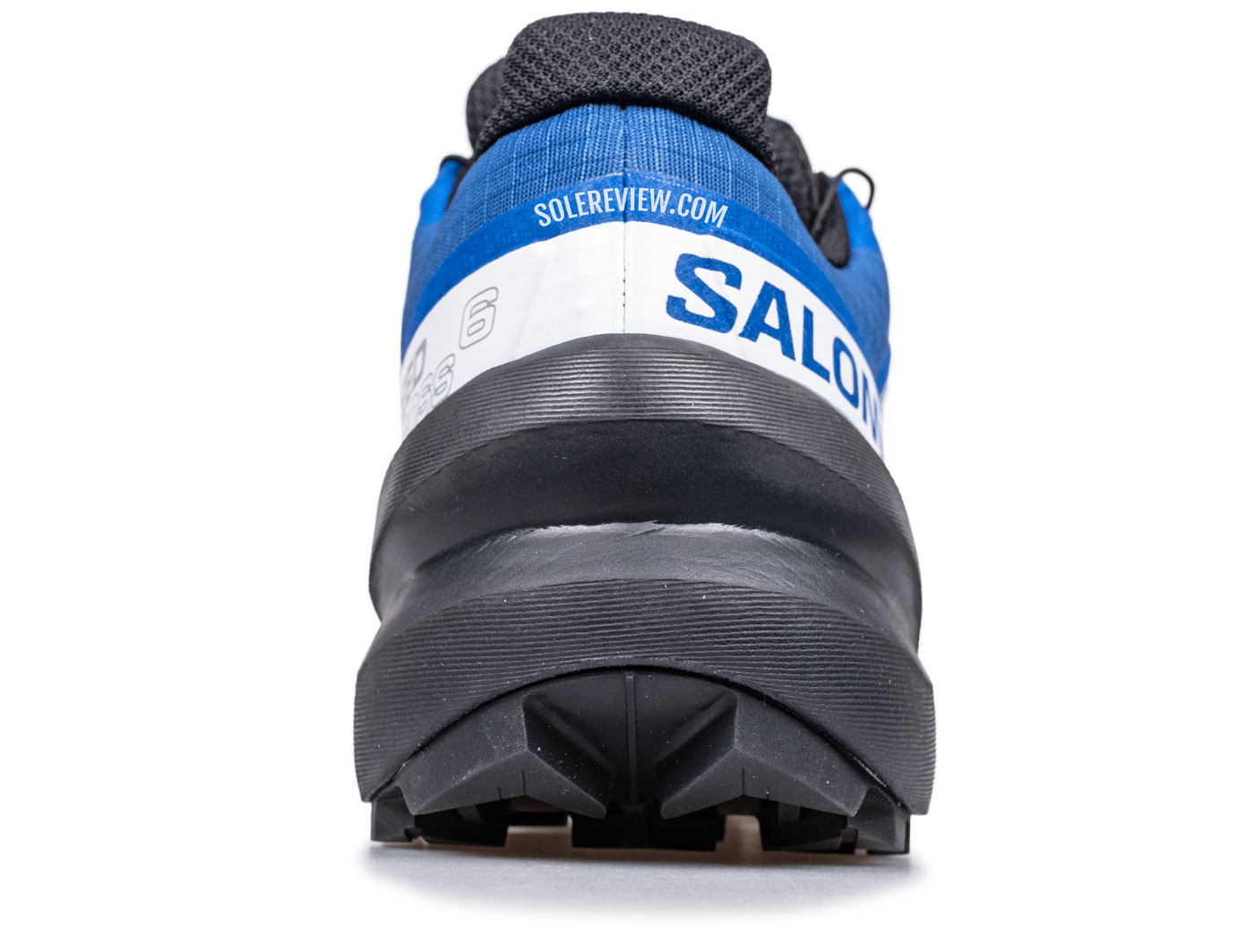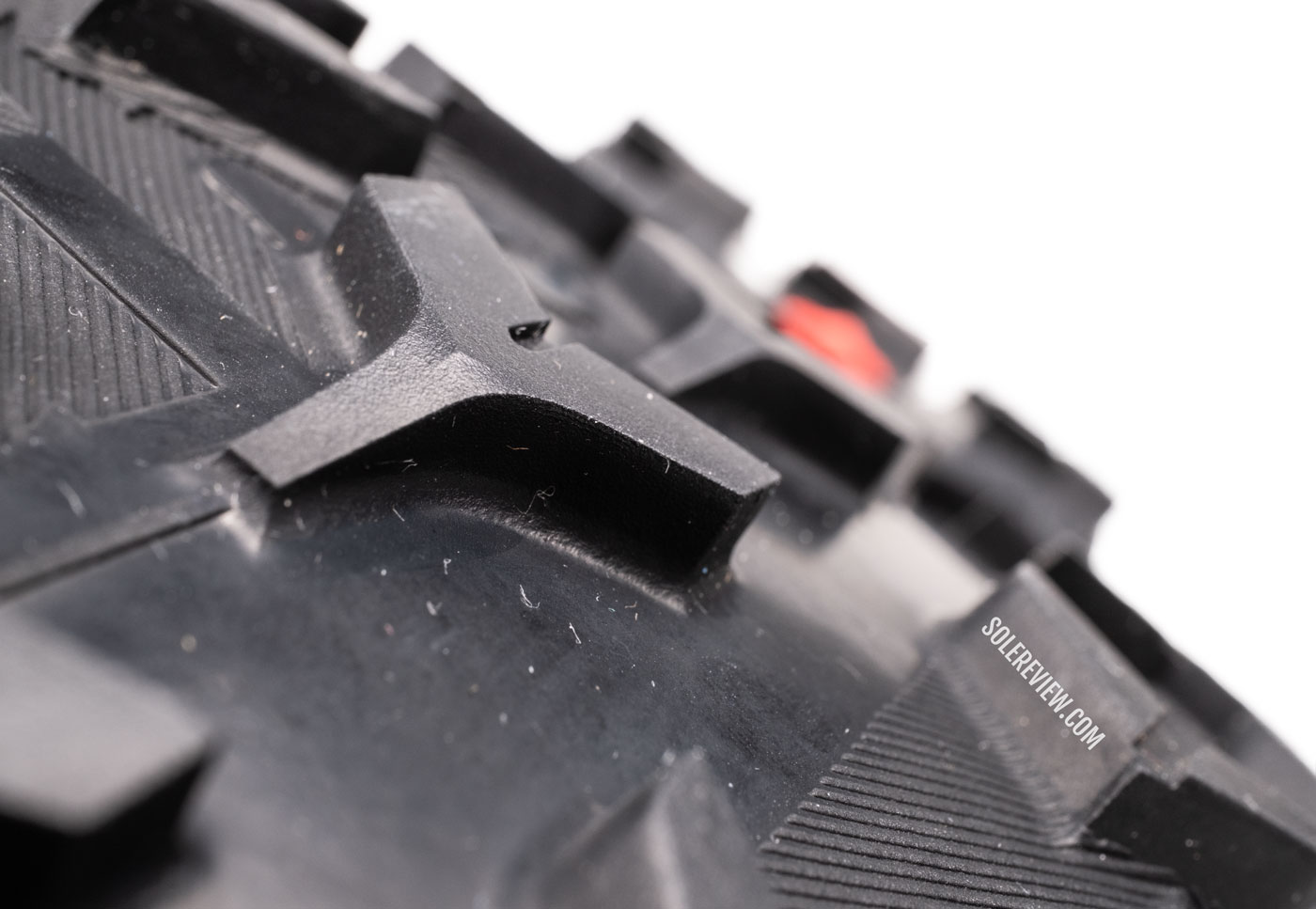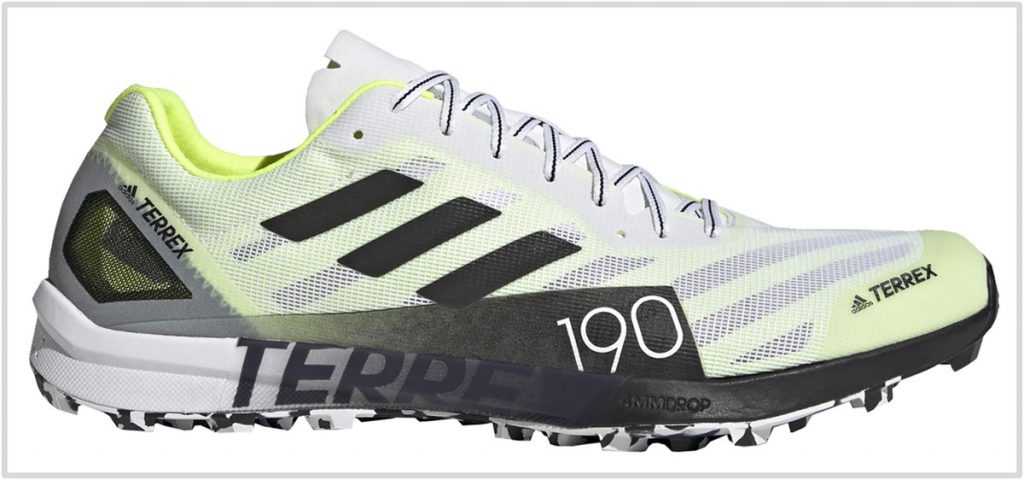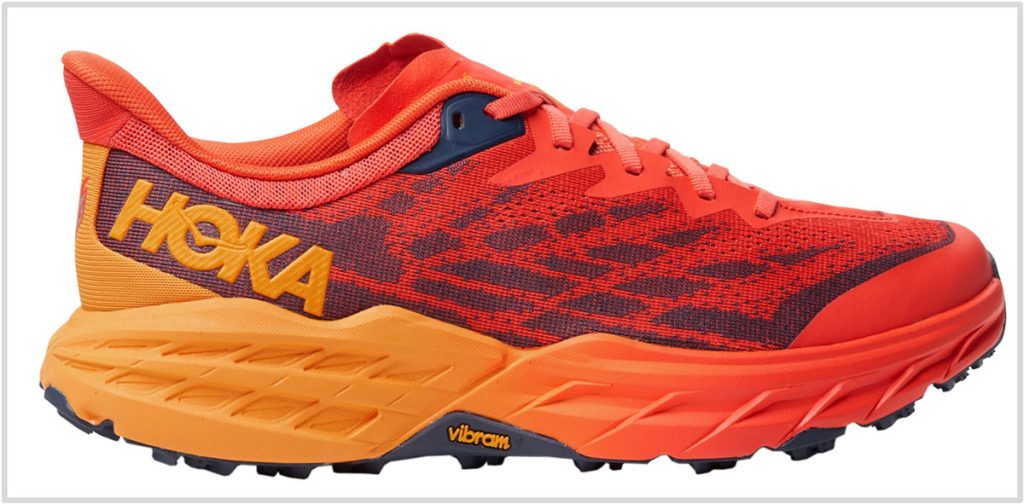This article has been updated with current models for October 2022. The Nike Pegasus Trail 4 and Salomon Speedcross 5 have been replaced with their updated versions. Except for the narrower ‘B’ width, the women’s models are almost identical to men’s.
In this product guide:
- 1. Factors to consider
- 2. Road-trail hybrid with a soft ride: Nike Pegasus Trail 4
- 3. Road-trail hybrid with a soft ride: New Balance Hierro V7
- 4. All purpose trail running shoe: adidas Terrex Agravic Flow 2
- 5. Speed trail running shoe: Saucony Peregrine 12
- 6. All purpose trail running shoe: Nike Terra Kiger 8
- 7. All purpose trail running shoe: Salomon Sense Ride 4
- 8. All purpose trail running shoe: Altra Lone Peak 6
- 9. Cushioned trail running shoe: Hoka Challenger ATR 6
- 10. Cushioned trail running shoe: Brooks Cascadia 16
- 11. All-purpose shoe for technical trails: Salomon Speedcross 6
- 12. Speed shoe for technical trails: adidas Terrex Speed Ultra
- 13. Speed shoe for technical trails: Hoka Speedgoat 5
If we consider use cases, trail shoes are similar to road running shoes.
For example, the Nike Pegasus 39 is a versatile road trainer that is capable of most runs. You can wear them for fast runs, slow runs, unpaved gravel roads, packed trails, or even marathons.
Sure, the Pegasus doesn’t excel in one specific area but if you had to buy just one shoe, this is as good as it gets. Similarly, there are many trail shoes with do-it-all versatility.
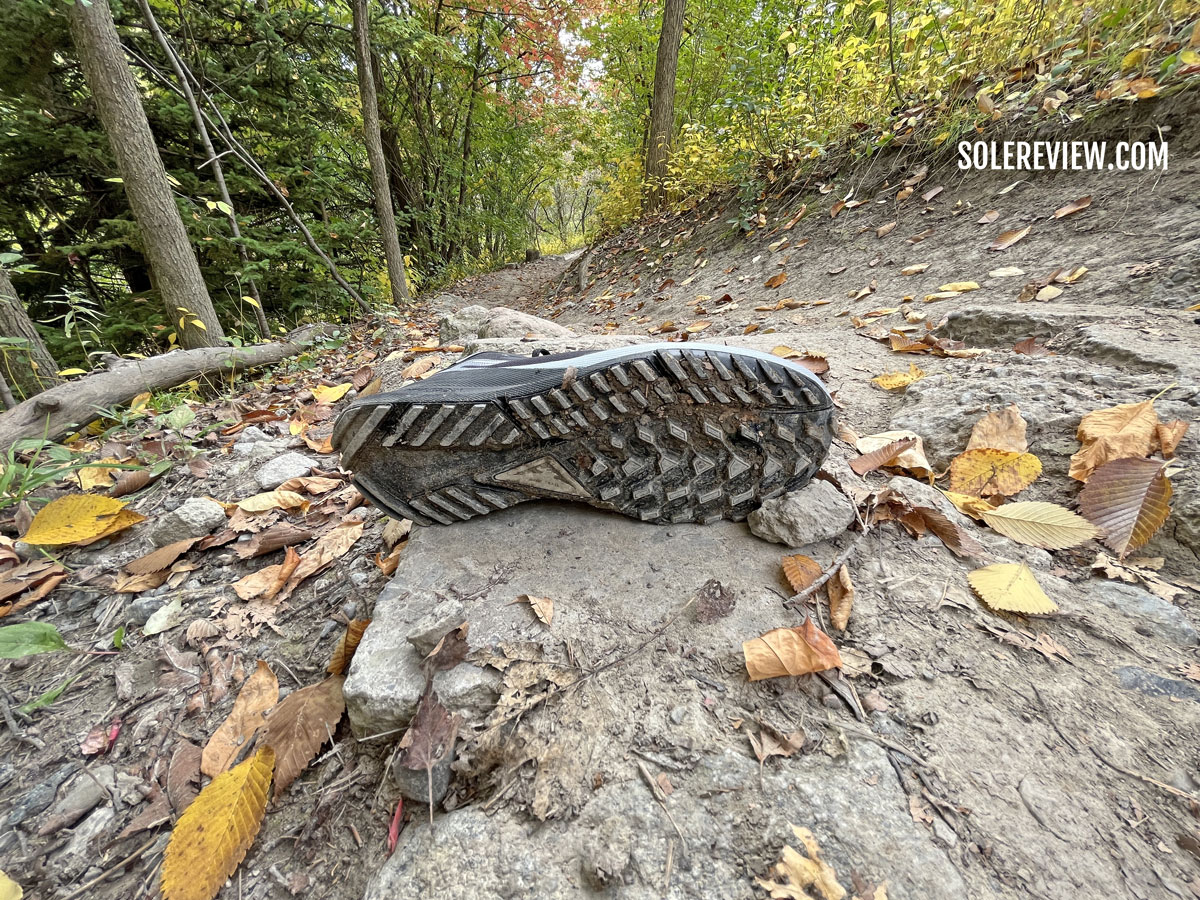
‘Technical’ road shoes are specifically designed for racing and fast running times. These could be low-profile racing flats or hybrid products like the adidas Boston 11. Here, a narrow uppers helps with a superior lock-down during speed runs.
There are parallels in the trail running shoe world. Technical trail running is more than just speed; there’s no single definition of that term – a lot depends on the terrain and/or the weather.
That said, all technical trails present a high level of difficulty due to their unpredictability. There could be other variables like dust/mud, loose rocks, ice, snow, and the occasional stream crossing.
It is common for technical trails to have steep uphill and downhill sections, both of which have different requirements for running shoes. Your running speed is a lot higher downhill and you’re constantly scanning the surface for good landing spots between the roots and loose rocks. This is a high speed, high (foot) cadence activity.
Unlike road or flat gravel paths, technical running isn’t linear. Where and how you land isn’t predictable; you’re thinking on your feet. Therefore, a shoe that encourages proprioception is preferable.
A technical trail runner will make a lot of side-to-side movements spread across a variety of foot-strike patterns. You could be forefoot, midfoot, or heel landing depending on the situation. That’s just downhill running; climbing steep verticals present its own set of challenges.
Therefore, the choice of a trail shoe will depend on where you plan to run.
Are your ‘trail’ runs limited to gravel paths in the neighborhood park? In that case, you do not need a purpose-built trail shoe. A road shoe would so just fine.
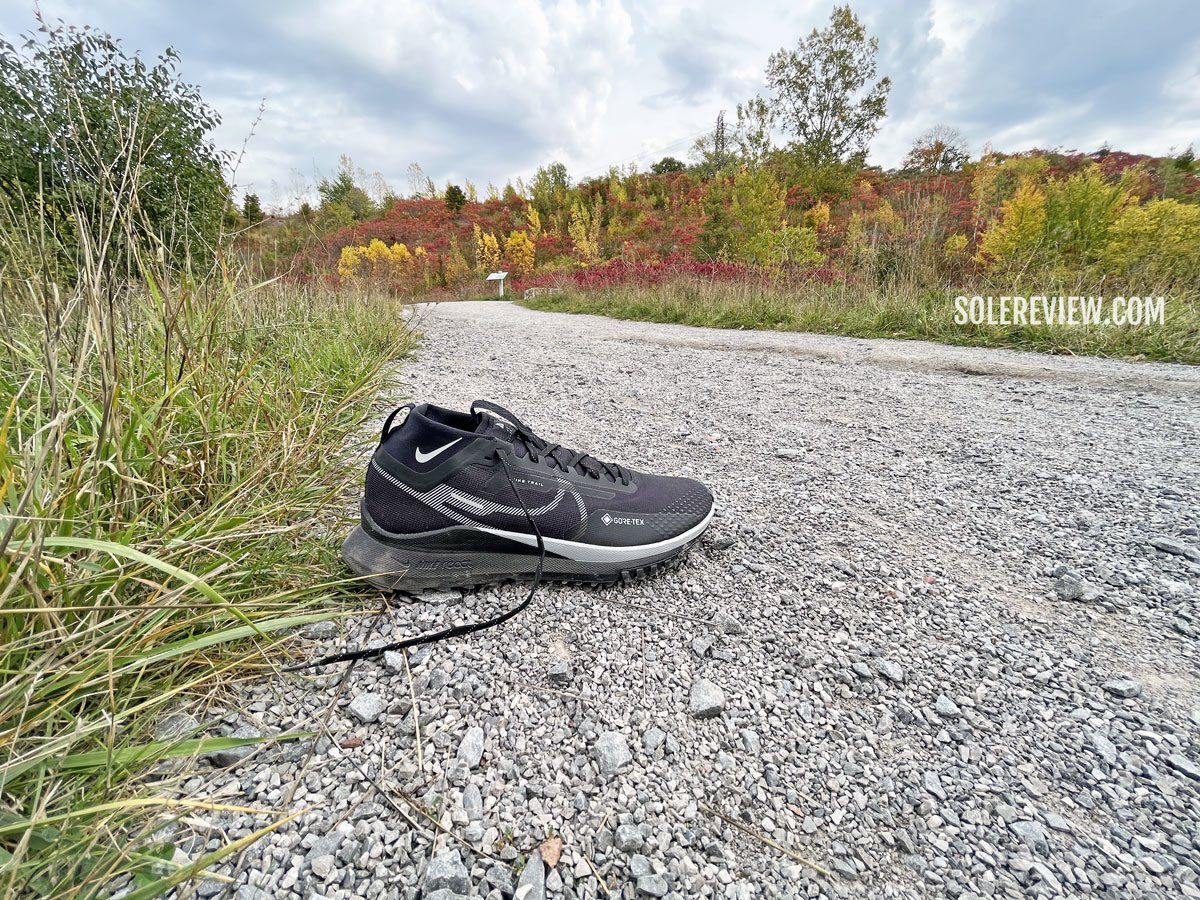
There’s a good reason why the Nike Pegasus Trail is called a road-trail hybrid. It’s closer to a road shoe than a serious trail runner. It does best on flat terrain – like this gravel path, for example.
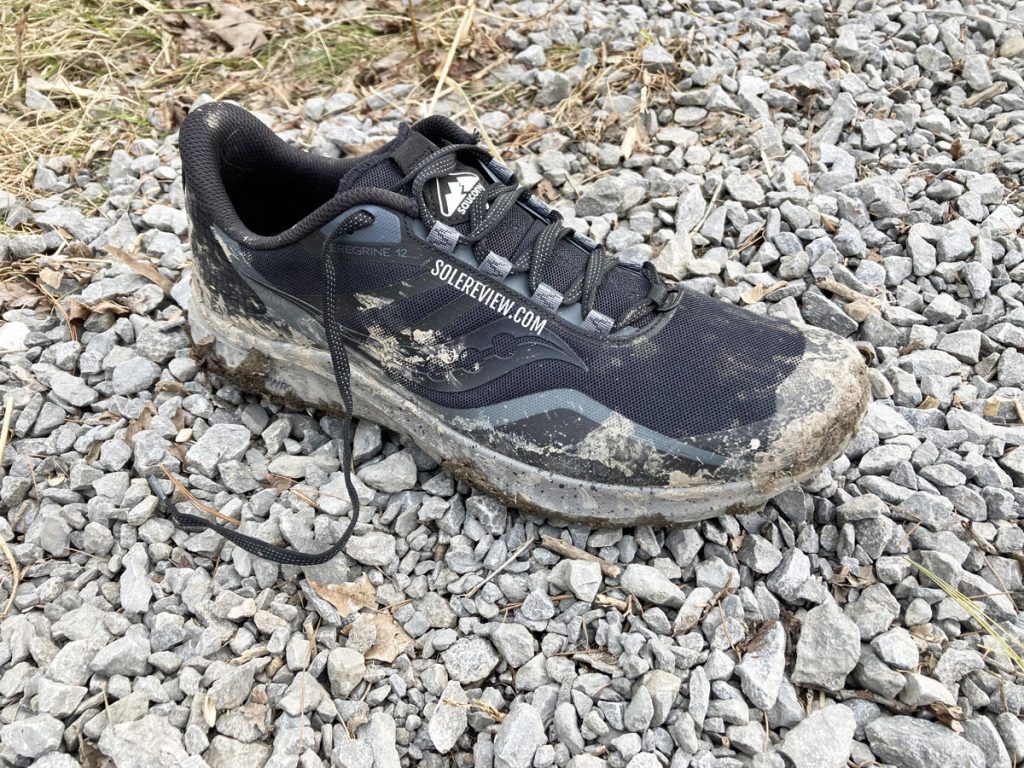
The Saucony Peregrine 12’s midsole and rock shield filters the pressure from small rocks on gravel trails.
If you want an outdoor-sey feel, then get one of those ‘soft-roaders.’ These are outdoor versions of the road shoe(s) with a rugged outsole and an upper made of dust-resistant mesh.
They’re like the footwear equivalent of compact SUVs or crossover vehicles. The Nike Pegasus Trail 4 and New Balance Hierro V7 are such examples.
Versatile trail running shoes like the Altra Lone Peak 6, Brooks Cascadia 16, and the Saucony Peregrine 12 perform well on everything from entry to medium-difficulty level trails. The uppers and the sole composites are decently protective, and the cushioned ride absorbs a lot of the bumps and pokes. They even work well on the road sections.
Technical trails are where shoe choices become complicated. Should you get a shoe with a thin sole, so that you can feel the ground for a better sense of weight and power transfer? But risk getting jabbed under the foot with rocky edges or sharp roots?
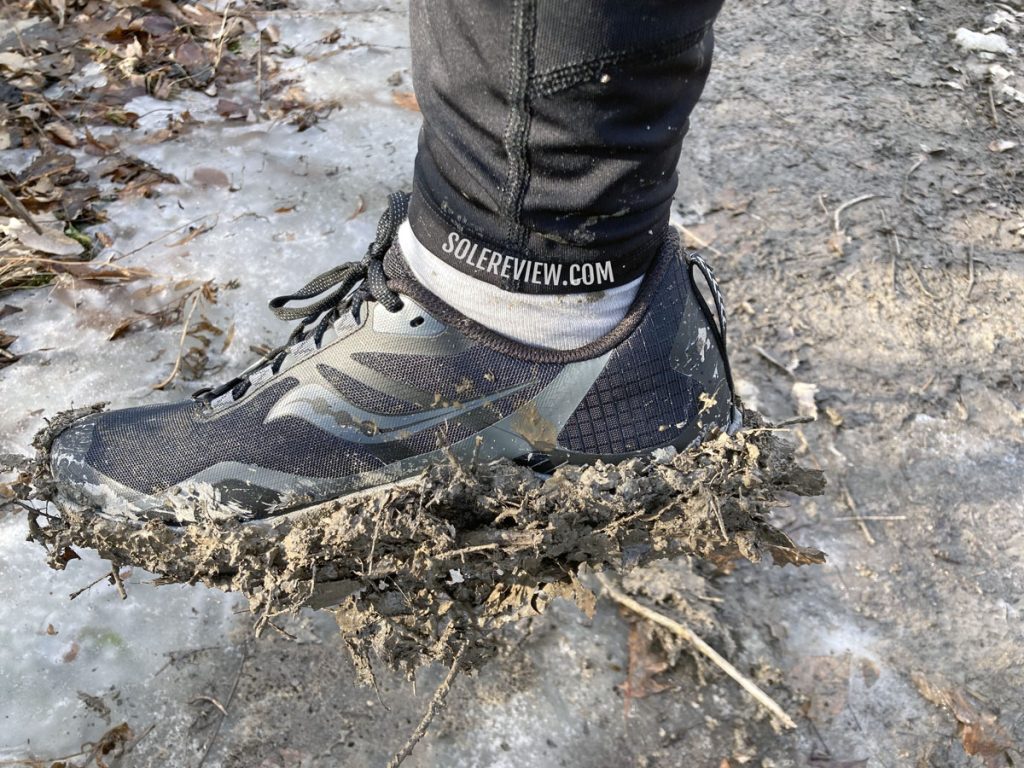
The outsole is ‘sticky’ for sure. The closely-spaced lugs and exposed rock shield tends to clog on soft terrain.
Or does it have to be a highly cushioned shoe for impact protection and high-mileage comfort?
If you’re running on slippery terrain, then the outsole needs to be shod with the right geometry of sticky rubber. That, of course, would be an overkill on dry trail paths because that could accelerate the wear and tear. On muddy trails, longer lugs and a tacky rubber compound are pre-requisites.
Nailing the upper fit is the key. Too much room, and you may end up with the unwanted ‘sliding off the midsole’ sensation. Too short, and the downhill hill sections will cause the toes to jam forward into the reinforced toe bumper. That’s not desirable.
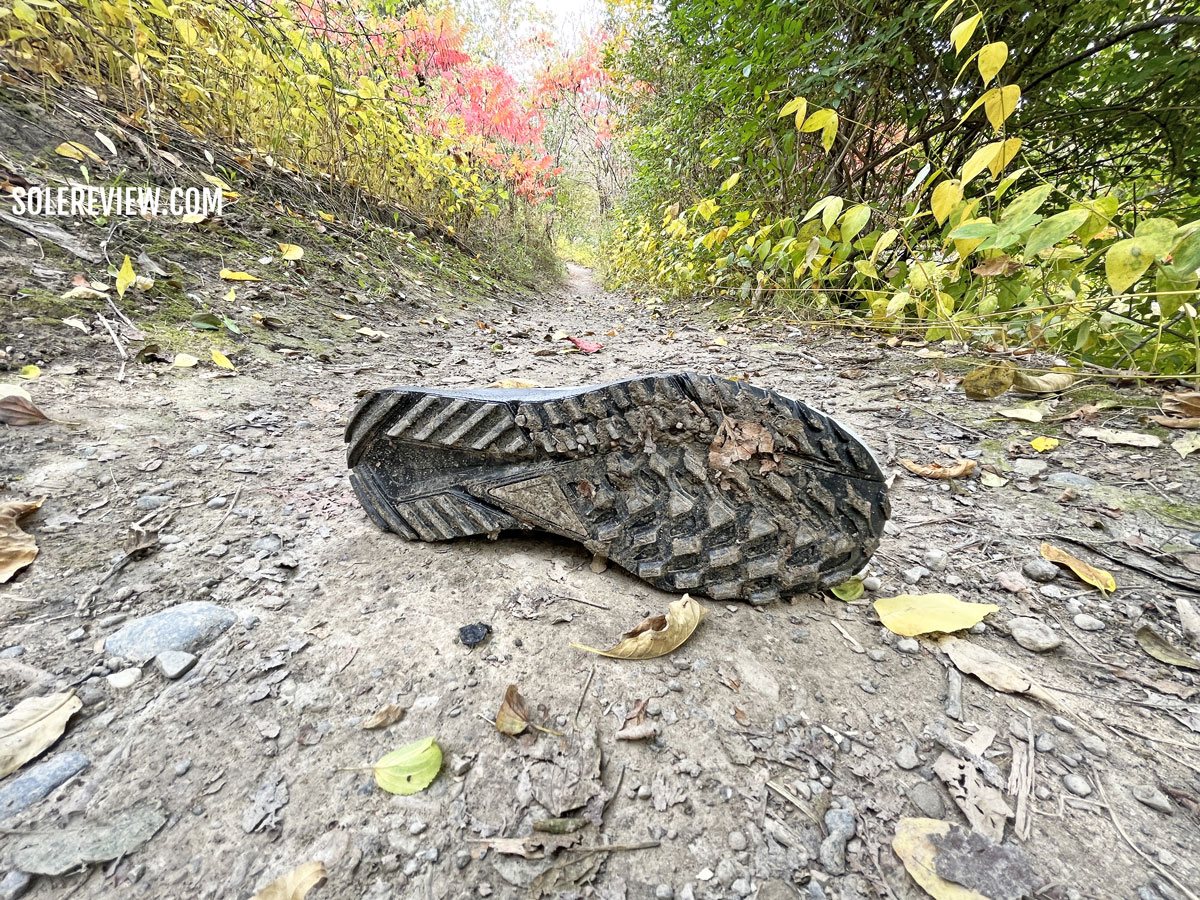
The Pegasus Trail 4 is a road-trail hybrid – a running shoe for easy trails.
Given the complexity, the best we can do is to recommend trail running shoes based on intended use-cases. The first two groups – the soft-roaders and versatile trail running shoes – are pretty straightforward.
The ‘right’ kind of technical trail shoe depends on how you like them served – so our third group brings together a diverse selection of models to choose from.
While this guide recommends a well-rounded assortment of trail shoes, you may also want to read up our waterproof, reflective, and winter running shoe guides for more options.
Crossover trail running shoes – these are the outdoor interpretation of road shoes.
These are your familiar road models re-purposed in a trail form. This way, you get the favorite parts of the road shoe – including a medial post – but with an off-road-ready outsole and color scheme.
1) Nike Pegasus Trail 4 Gore-Tex
The Pegasus Trail 4 is an excellent shoe for low speed trail runs on flat trails and roads. Our in-depth review has everything that you need to know.
Its soft React foam midsole packs a lot of comfort for high-mileage runs. While the new outsole isn’t as protective as the Pegasus Trail 3, the aggressive lugs grip better on downhill sections.

Even though the midsole lacks a rock shield (like the Terra Kiger), the midsole is softer than the road Pegasus. The low levels of stability make it unsuitable for speed runs over technical terrains.
And like any Nike running shoe with React foam, the midsole will harden in below-freezing temperatures.
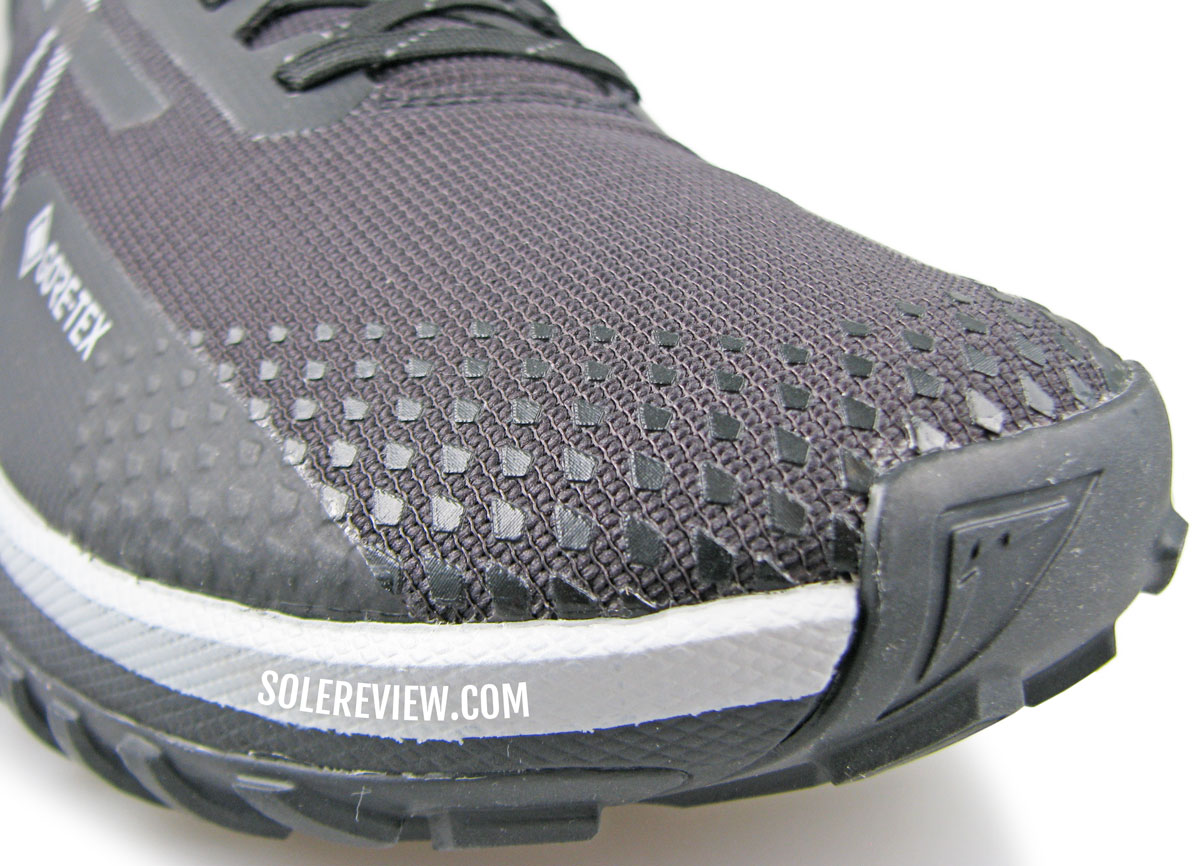
The Pegasus Trail 4’s toe-box is shallow – more so on the GTX version, thanks to the fused overlay.
The upper is smooth, secure, and reasonably protective. The outsole extends over the upper to form the toe-bumper, and high-density printing on the forefoot reinforces the upper.
We recommend the Gore-Tex variant due to its waterproof exterior. Not having to worry about the feet getting wet is a huge bonus.
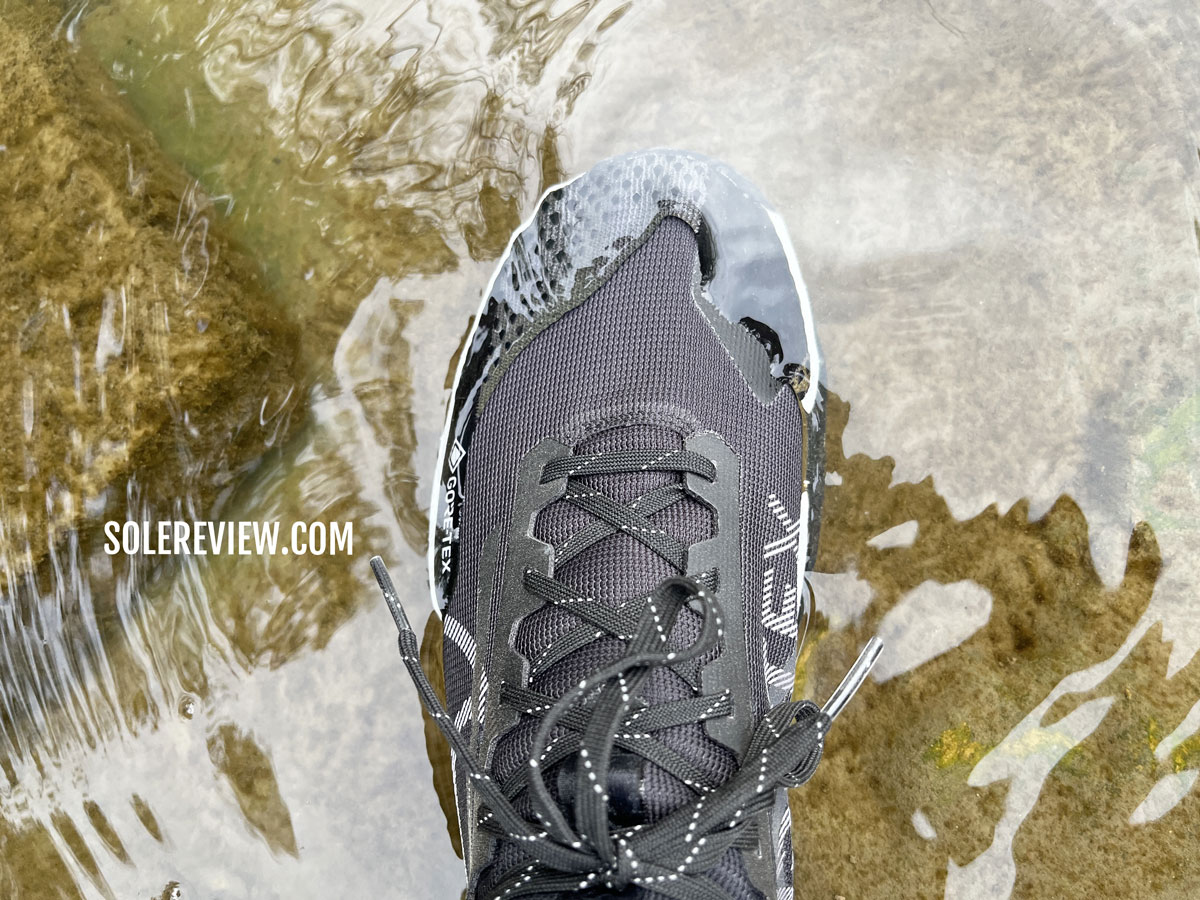
Just know that the Gore-Tex model fits a half size short. The standard Pegasus Trail 4 has a better midfoot fit because of Flywire lacing – a feature that is missing on the Pegasus Trail 4 GTX.
2) New Balance Fresh Foam Hierro V7
In more ways than one, the New Balance Hierro V7 is similar to the Nike Pegasus Trail.
The Fresh Foam midsole packs a generous amount of ride comfort, and the Vibram rubber outsole delivers multi-surface traction. There’s no rock plate, but the Hierro is adequately protective.
The mesh upper is protective too, thanks to the generous application of printed TPU. The sizing fits small and narrow, so buying a half size larger is recommended.
And just like the Pegasus Trail, we view the Hierro as a trail shoe for flat and mildly technical trails. The flat outsole lug geometry also makes it perfectly capable of road miles as well.
Versatile trail running shoes.
Use them every day on most terrains – as long as they aren’t extremely challenging trails.
1) adidas Terrex Agravic Flow 2
adidas revamped the Terrex Agravic Flow recently, and the new model is nothing like the old.
The previous model had a combination midsole that relied on a full-length Boost core with a supportive EVA frame. The bootie upper provided a narrow but ultra-secure fit over the trail.
The Agravic Flow 2 no longer uses Boost foam. In its place is a Lightstrike EVA foam midsole – the same cushioning material that’s used on the SL20 and partially on the adizero adios and Boston.
The result is a trail running shoe with a much higher level of stability. Adidas also reinforces the sidewalls with a thin film that it calls ‘Promoderator’.
The new midsole material and supportive frame deliver a firmly-cushioned ride experience on the off-road terrain. A full-length Continental rubber outsole has tall, widely-spaced lugs for traction.
Though the upper lacks a gaiter attachment ring, there’s a waterproof Gore-Tex available as well. For dry running conditions, the vented mesh and reinforcement layers create a protective yet breathable fit.
2) Saucony Peregrine 12
The Peregrine 12 was released in February, and that means that this model has been in existence for well over a decade.
Very few running shoe franchises last that long, so there’s a good reason why the Peregrine is still around. Despite the top-to-bottom redesign of the Peregrine 12, it gets all the trail shoe basics down pat.
Our in-depth review covers everything about the shoe.
The EVA foam midsole (Pwrrun) is cushioned and stable enough for a variety of trail runs; the forefoot rock shield protects the foot from the roots and rocks. And this is not a soft trail running shoe, but one with a firm ride that feels proprioceptive.
The outsole is made of the tacky Pwrtrac rubber that grips well on wet and dry terrain alike. Of course, smooth wet rocks and frozen surfaces are excluded.
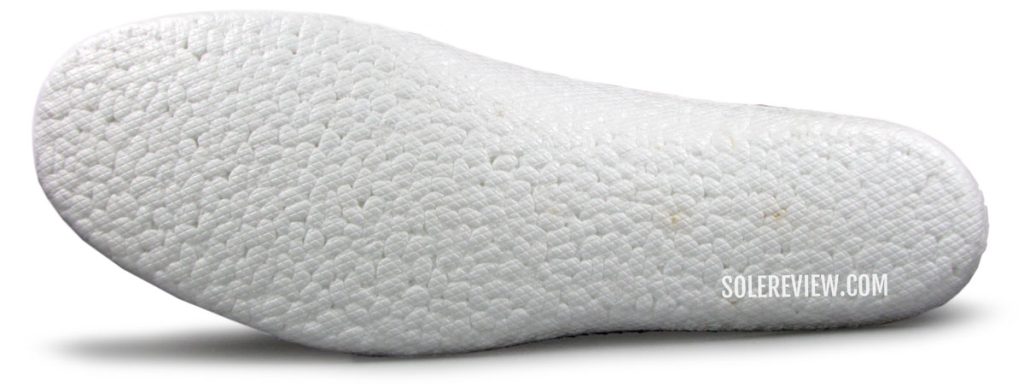
Everun, Pwrrun+ – call it whatever you will. The unique insole is no longer EVA foam, but steam-expanded Polyurethane.
It isn’t bereft of comfort. Saucony has equipped the V12 with a Pwrrun+ (E-TPU) insole for a step-in layer of softness.
The mesh and synthetic upper is comfortable as well as protective. The mesh tongue and padded heel provide a soft yet secure grip, whereas the fused side cladding protects the foot on the trail.
A ST (Soft Terrain) variant with bungee cord lacing is also available. Both the models have a metal D-ring for gaiter attachment.
3) Nike Terra Kiger 8
The Terra Kiger 8 has all the bits and pieces that an all-purpose trail running shoe needs to have.
There’s a protective rock plate under an outsole that’s made of sticky rubber for traction. The cushioning is delivered by the React foam midsole and a forefoot Zoom Air bag.
However, the Kiger 8 isn’t deeply cushioned shoe like the Wildhorse 7 or Pegasus Trail 3.
The midsole is relatively low to the ground (16.5 mm heel, 12 mm forefoot), and there’s a stiff Zoom bag inside. The low-profile ride is good for proprioception, as it helps the foot connect to the ground better.
The mesh part of the upper allows ventilation during warm summer runs while the synthetic welding over the toe and midfoot add support and protection. The upper fit is very secure; the loop-based lacing is excellent at locking the foot in.
There’s not a lot of difference between the Terra Kiger 7 and 8, as both the models share the same sole unit. However, the Kiger 8’s upper is extremely breathable because of the large pores.
Given the context, the breathable Kiger 8 will perform poorly on muddy terrain or rains. The Pegasus Trail 3 GTX or Cascadia 16 GTX are better choices for such surface conditions.
4) Salomon Sense Ride 4 – wet and dry trails
The Salomon Sense Ride is back for the fourth time, it hasn’t changed a lot over the Sense Ride 3. The midsole and outsole stay the same, so the only thing that’s changed is the upper.
The Sense Ride 4 now gets an updated heel collar that has padded ‘pockets’ for grip. The tongue flap has been redesigned, and it still has the love-it-or-hate-it ‘lace garage’. If you ask us, the next Sense Ride should just ditch the bungee laces and get a normal pair of laces.
The fit is still great at securing the foot without slippage; the bungee-style Quicklace is cumbersome but effective.
The ride comfort is delivered by the foam blend that Salomon calls ‘Optivibe’, so the Sense Ride 4 is excellent for longer trail runs. The firm undertone gives the Ride 4 plenty of stability and an efficient transition quality.
The widely-spaced outsole lugs provide excellent grip without relying on an aggressive geometry. This middle-ground approach to the outsole design also makes the Sense Ride 3 suitable for the occasional trail-to-road crossover.
The upper isn’t waterproof, but there’s a Gore-Tex variant for a $40 premium.
5) Altra Lone Peak 6
This is the only trail running shoe on this guide with a 0 mm heel-to-toe offset. Be it the heel or the forefoot, the midsole thickness stays the same.
The zero-drop midsole helps during full-contact landings while creating a cushioned layer between the foot and the trail.
The Altra Lone Peak 6 is all function over form. It lacks a ‘modern’ appearance, but it has all the functionality that a versatile trail shoe needs. The ‘stoneguard’ plate offers protection from unwanted jabs, and sticky rubber (MaxTrac) lugs offer multi-terrain traction.
The layering on the upper results in a snug fit that prevents the foot from sliding while serving as protection from the bumps and nicks. The Lone Peak 6 also has a gaiter attachment point should you need one. The protective ripstop mesh and tongue keep the debris out.
6) Hoka Challenger ATR 6
Some trail runners prefer a max-cushioned ride for long-distance comfort; here’s just the shoe for it.
The Hoka Challenger ATR 6 does not have a rock plate but its midsole is thick enough to act as a protective barrier. The wide midsole and outsole geometry make the ride supportive too. The partial outsole doesn’t have an aggressive lug geometry but offers sufficient traction over non-technical surfaces.
Hoka uppers have become progressively better with passing years, and the ATR 6 benefits from those improvements as well. The redesigned upper is smooth, comfortable, and has more room than the ATR 5.
7) Brooks Cascadia 16 GTX – wet and dry
The Brooks Cascadia 16 GTX is a solid choice for trail runners who want a cushioned shoe to go the distance, but with all the bells and whistles of a fully-loaded trail shoe.
For example, the midsole has a flexible rock plate that’s protective and doesn’t get in the way of midsole comfort. The ‘Trailtack’ rubber outsole is grippy on most surfaces (except smooth rocks and snow), and the upper has gaiter-attachment points.
Both the standard and Gore-Text Cascadia models share the same midsole and outsole, so the ride character is identical.
The single-density EVA foam stack is extremely comfortable for high-mileage trail runs while providing adequate stability. This is despite the midsole losing the ‘Pivot Posts’ that existed on the earlier Cascadia models.
Given the cushioned ride, the Cascadia 16 has weak proprioceptive feedback. So while this is a versatile trail shoe, speed runs on technical grades aren’t its forte. The wide midsole also results in a relaxed upper midfoot fit – something that gets in the way of speed runs.
Other than that, the upper is accommodating and smooth on the inside. The waterproof Gore-Tex upper is stiffer than the standard version due to the laminate, but it’s great at keeping the water out.
Also see: The Salomon Ultra Glide; it has a narrower fit.
Technical trail running.
Reserve these shoes for the toughest of terrains and gradients. Most of them work on wet, slippery surfaces.
1) Salomon Speedcross 6
If running on muddy or slushy trails is your idea of fun, then it’s hard to go wrong with the Speedcross 6.
The long and widely spaced lugs (made of soft rubber) bite deep with minimal clogging. The heel and forefoot lugs face different directions for ample traction on uphill and downhill sections. For our review, we tested the Salomon Speedcross 6 on different terrains and surface conditions.
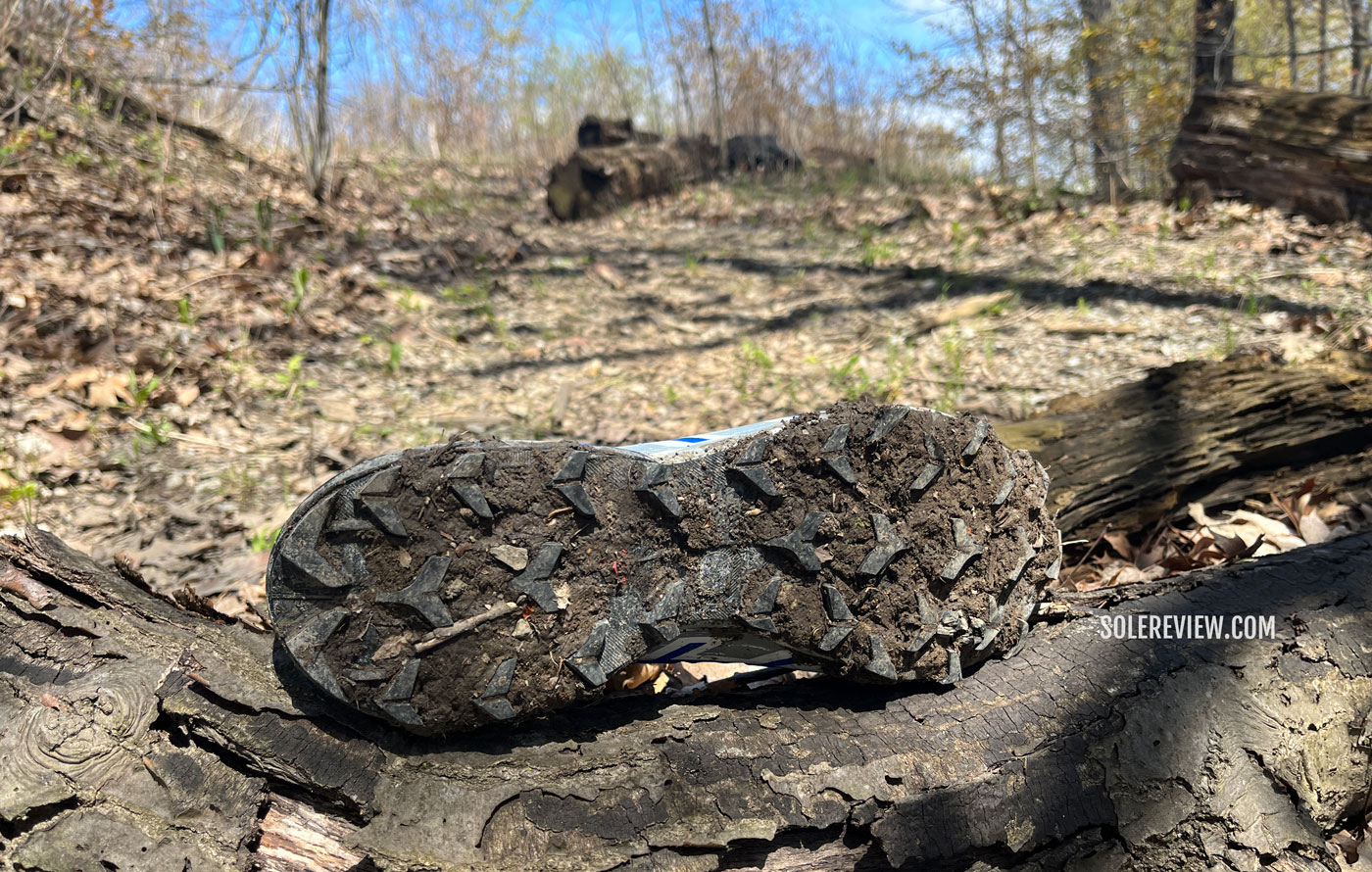
The outsole isn’t clog proof. That said, the wide spacing of the lugs make it easy to dislodge the mud and debris.
The ultra-slim outsole profile helps too. The narrow width exerts a greater pressure on the lugs, thus improving the grip over challenging trails. Making that possible is a ‘double-lasted’ construction of the Speedcross 6.
Here, the upper covers the midsole and folds just over the outsole. This unique construction not only results in a slim outsole but also secures the foot better over challenging terrain. The Ortholite insole and internal midsole combine to create a cushioned and stable base for long-distance runs.
The Speedcross upper is functional minimalism at its best. Fused layers cover a closed mesh to deliver dust-free protection. We recommend the waterproof Gore-Tex version for all weather use.
2) Speed trail running shoe: adidas Terrex Speed Ultra Trail
Coming to think of it, there aren’t many good trail shoes designed for speed-oriented off-road use.
The adidas Terrex Speed Ultra proves to be an exception. It’s fast and stable on uneven terrain, and that ride quality doesn’t exclude cushioning comfort and protection. The rear midsole has a resilient Boost foam core, and the rest of the midsole is supported by a firmer Lightstrike EVA frame.
Having the firm EVA under the forefoot not only makes it protective, but also enhances the stability and ground feedback.
This is where the ‘Speed’ part of the Terrex Speed Ultra kicks in. The firm midsole works together with the grippy Continental rubber outsole for efficient transitions; the snug upper also plays its part in keeping the foot secured over the trails. There’s no waterproofing though.
3) Hoka Speedgoat 5 – wet and dry
The fact that this Hoka shoe comes standard with a Vibram Megagrip outsole shows that it means business. This Vibram compound offers traction over wet slippery surfaces while the 5 mm lugs bite into the ground for a confidence-inspiring grip.
The firm midsole helps with the ride stability over uneven terrain and is also an effective barrier against the roots and rocks.
The upper comes standard with reinforced toe and midfoot sections for protection. For this year, the Speedgoat 5 gets a brand-new knit upper with a softer heel collar for improved interior comfort.
Do you own any of these shoes? Improve this review by sharing your insights – submit a review here.

